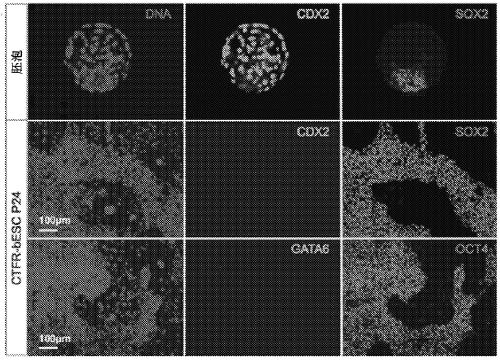Efficient derivation of stable pluripotent bovine embryonic stem cells
An embryonic stem cell and cell technology, which is applied in the field of efficient derivation of stable pluripotent bovine embryonic stem cells, can solve the problems of poor derivation efficiency, loss of proliferation ability and pluripotency markers, and failure to pass pluripotency tests.
- Summary
- Abstract
- Description
- Claims
- Application Information
AI Technical Summary
Problems solved by technology
Method used
Image
Examples
Embodiment approach
[0089] Method for producing stable embryonic stem cells
[0090] Provided herein is a method for producing stable ungulate embryonic stem cells (ESCs), the method comprising, or consisting essentially of, or consisting of: culturing in a cell culture medium from an ungulate ungulate blastocyst cells or pluripotent cells isolated from animal-like embryos, the cell culture medium containing: (i) inactivated feeder cells; (ii) an effective amount of fibroblast growth factor 2 (FGF2) or its equivalents; and (iii) an effective amount of one or more Wnt signaling inhibitors. In one aspect, the ungulate blastocyst, pluripotent cell or ESC is bovine or ovine. In another aspect, the blastocyst cells, pluripotent cells or ESCs are detectably labeled.
[0091] The methods disclosed herein use the disclosed compositions and culture conditions to establish ungulate ESCs (e.g., bovine embryonic stem cells) that are multipotent, readily proliferate using single cell dissociation by trypsin...
Embodiment 1
[0126] CTFR medium supports derivation and long-term culture of pluripotent bESCs
[0127] In serum-free custom TeSR1 basal medium (without growth factors) supplemented with FGF2 and IWR1 ( C ustom T eSR1base medium supplemented with F GF2 and IW R 1) (referred to herein as "CTFR") conditions, bESCs were derivatized, propagated, cultured and subjected to several rounds of freezing and thawing. Cell lines can be established by the end of week 3 after ICM / embryo plating and remain unchanged for more than 50 passages (Figure 1). Unlike human ESCs and mouse EpiSCs, CTFR-bESCs did not display round colony morphology with clearly defined edges, but instead tightly adhered to each other, forming an interconnected honeycomb network that Clearly separated from the feeder layer ( Figure 1A ). CTFR-bESCs stained positive for alkaline phosphatase (AP) ( Figure 1A ). To assess the genetic stability of CTFR-bESCs after long-term culture, Applicants performed karyotype analysis in ...
PUM
 Login to View More
Login to View More Abstract
Description
Claims
Application Information
 Login to View More
Login to View More - R&D
- Intellectual Property
- Life Sciences
- Materials
- Tech Scout
- Unparalleled Data Quality
- Higher Quality Content
- 60% Fewer Hallucinations
Browse by: Latest US Patents, China's latest patents, Technical Efficacy Thesaurus, Application Domain, Technology Topic, Popular Technical Reports.
© 2025 PatSnap. All rights reserved.Legal|Privacy policy|Modern Slavery Act Transparency Statement|Sitemap|About US| Contact US: help@patsnap.com



